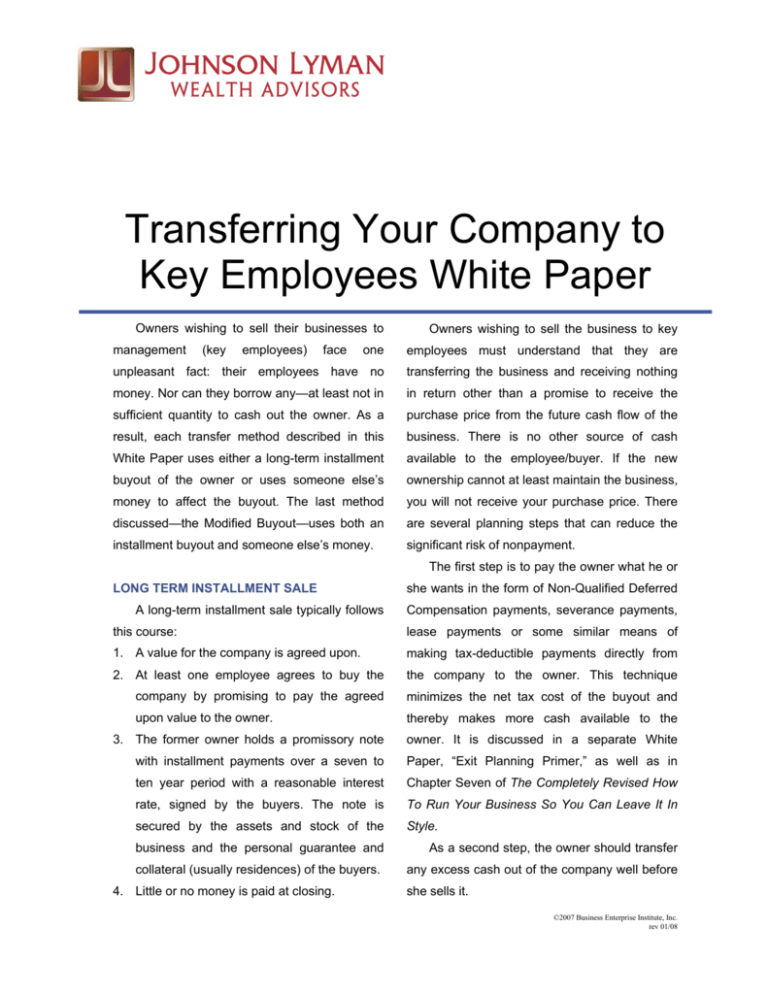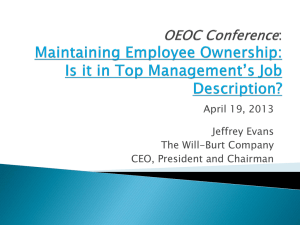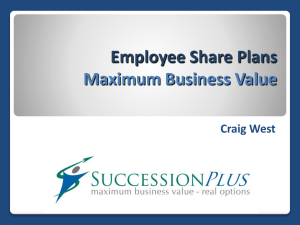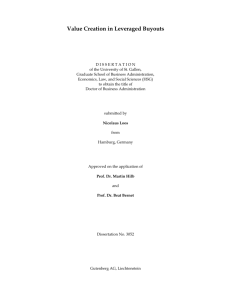Transferring Your Company to Key Employees White Paper
advertisement

Transferring Your Company to Key Employees White Paper Owners wishing to sell their businesses to management (key employees) face Owners wishing to sell the business to key one employees must understand that they are unpleasant fact: their employees have no transferring the business and receiving nothing money. Nor can they borrow any—at least not in in return other than a promise to receive the sufficient quantity to cash out the owner. As a purchase price from the future cash flow of the result, each transfer method described in this business. There is no other source of cash White Paper uses either a long-term installment available to the employee/buyer. If the new buyout of the owner or uses someone else’s ownership cannot at least maintain the business, money to affect the buyout. The last method you will not receive your purchase price. There discussed—the Modified Buyout—uses both an are several planning steps that can reduce the installment buyout and someone else’s money. significant risk of nonpayment. The first step is to pay the owner what he or LONG TERM INSTALLMENT SALE A long-term installment sale typically follows she wants in the form of Non-Qualified Deferred Compensation payments, severance payments, this course: lease payments or some similar means of 1. A value for the company is agreed upon. making tax-deductible payments directly from 2. At least one employee agrees to buy the the company to the owner. This technique company by promising to pay the agreed minimizes the net tax cost of the buyout and upon value to the owner. thereby makes more cash available to the 3. The former owner holds a promissory note owner. It is discussed in a separate White with installment payments over a seven to Paper, “Exit Planning Primer,” as well as in ten year period with a reasonable interest Chapter Seven of The Completely Revised How rate, signed by the buyers. The note is To Run Your Business So You Can Leave It In secured by the assets and stock of the Style. business and the personal guarantee and As a second step, the owner should transfer collateral (usually residences) of the buyers. any excess cash out of the company well before 4. Little or no money is paid at closing. she sells it. ©2007 Business Enterprise Institute, Inc. rev 01/08 Third, the owner can enhance security • A management team that is capable of through: operating and growing the business without • your involvement. • • Securing personal guarantees (collateral, both business and personal); • Stable and predictable cash flow. Postponing the sale of the controlling • Good prospects for future prosperity and interest; growth. The growth of the company should Staying involved until satisfied that cash flow be described in detail in a management- will continue; prepared business plan. • Obtaining partial outside financing; and • Selling part of the business to an outside accounts receivable, inventory, machinery party. and equipment. Hard assets make it easier These techniques reduce but do • to finance the acquisition through the use of not debt, eliminate risk. For that reason, owners typically have complete confidence in their employees and in the economy to support the company’s prosperity. The most common reason, however, for exiting using the long term installment sale is that the owner has failed to create a less risky but service companies without significant tangible assets can obtain debt undertake this type of sale only if no alternative exists, if they don’t need the money, or if they A solid tangible asset base, such as financing, albeit at higher cost. • Have a fair market value of at least $5 million (probably $10 million in order to attract the interest of private equity investors). The prerequisite for a management-led leveraged buyout is that you, as the seller, and exit plan. the management team agree on a fair value for the company. The parties then execute a letter LEVERAGED MANAGEMENT BUYOUT This transaction structure draws upon the of intent giving management the exclusive right outside to buy the company at the agreed price for a equity or seller equity, and significant debt specified period of time (typically 90 to 120 financing. This structure can be an ideal way to days). The management team and its advisors reward the subsequently arrange the senior bank debt to company for growth, and minimize or eliminate fund a portion of the transaction. This bank debt your ongoing financial risk. usually requires management to arrange to company’s management your key resources, employees, position leveraged make an equity investment prior to closing. It is management buyout, your business should at this point that the management team and its possess the following characteristics. advisors seek an equity investor. They offer the To effectively execute a equity investor a complete package of price, terms, debt financing, and management talent. ©2007 Business Enterprise Institute, Inc. rev 01/08 The equity investor need only weigh the only problem was that it had only $750,000 reasonableness of the projected return on his collectively from second mortgages on their investment. homes. Consequently, they hired an investment There are many professionally managed banking firm to help them arrange financing to private equity investment funds that actively close the transaction. With the clock ticking on seek management leveraged buyouts as a their preferred investment. These private equity funds motivated to make the deal. control billions of dollars of capital for investment which they may structure as senior debt, subordinated debt, equity or some combination exclusivity period, management was The transaction was ultimately structured as follows: In this transaction, management owned 20 thereof. This investment flexibility enables the percent private equity investment firms to be much more investing only nine percent of the equity funds nimble than your local commercial banker. The needed to close the transaction. Six years later, investment philosophy of these private equity all of the debt that had been used to buy the investors is captured in the slogan of a company had been repaid. The outside equity successful buyout group: “We partner with investors management to create value for shareholders.” investment and the management team reaped From management’s perspective, a of the equity received ownership, five times their despite initial their initial investment ten-fold. significant advantage to working with a private Another advantage of the management equity firm is that most will continue to invest in leveraged buyout is its flexibility. If an outside the company after the acquisition to fuel the private equity investor cannot be located under company’s growth. These private equity firms acceptable terms, the seller can elect to will also allow management to receive a maintain an equity position in the company, or “promoted interest in the deal.” This means that subordinate a term note to the bank. management can earn greater ownership in the company than it actually pays for. To help you better understand As you can see, a management leveraged buyout may enable a business owner to the accomplish mechanics of this process, let’s look at one objectives. the majority of his original highly-profitable medical device manufacturing business with revenues of approximately $5 EMPLOYEE million. The owner wanted out of the business (ESOP) and was willing to sell it to management under An ESOP is a tax-qualified retirement plan (profit the condition that the transaction be completed sharing and/or money purchase pension plan) within 60 days. The agreed upon sale price was that must invest primarily in the stock of the $8 million, payable in cash to the owner at company. In operation, it works just like a profit closing. The management team’s biggest and sharing plan: the company’s contributions to the STOCK OWNERSHIP PLAN ©2007 Business Enterprise Institute, Inc. rev 01/08 ESOP are tax-deductible to the company and There are substantial financial and other tax-free to the ESOP and its participants (who costs associated with an ESOP; after all, there is are essentially all of the company’s employees). a reason that there are fewer than 25,000 active In the context of selling at least part of the ESOPs. The benefits and limitations of ESOPs business to the key employees, the ESOP is are described in our ESOP White Paper. For used to accumulate cash as well as to borrow now, consider it a method worthy of exploration money from a financial institution. It uses this with your legal, tax and financial advisors. money to buy the business owner’s stock. Provided certain additional requirements are MODIFIED BUYOUT met, the owner can take the cash from this sale, Despite its catchy title, this method really is reinvest it in “qualifying securities”—publicly the workhorse of the group. It is the one that traded stock and bonds—and pay no tax until he works best for most owners who want to: sells those securities. • Transfer their businesses to key employees; The participants in the ESOP then own, • Motivate and retain key employees; and indirectly, the stock purchased by the plan. Key • Receive full value for their businesses employees will likely own a significant part of that stock because ESOP allocations to participants are based on compensation. Typically, however, key employees will want more than indirect ownership. They will want to control the company and have the possibility of owning a disproportionate amount of the company by purchasing stock directly from the owner before the owner sells the balance of this stock to the ESOP. By owning all of the stock not owned by the ESOP, the key employees can effectively control the company. The net result is an ownership structure not unlike the management LBO. An ESOP, rather than an outside investor, owns and pays cash for a majority interest in the company. The existing management operates the business and has significant ownership. The owner is largely cashed out of the business, perhaps having to carry only a portion of the purchase price of the stock sold to management. The difficulties and opportunities presented to owners as they transfer their businesses to key employees using the Modified Buyout are summarized on the last page. Dan Hudson was the owner of an electronic parts distribution company, “EPD.” His was a 45employee company with revenues of over $6 million per year and a fair market value of $5 million. At age 52, Dan planned to stay with the company for at least five more years. EPD employed a half dozen experienced senior managers and salesmen. Dan was interested in both employees to the economically “handcuffing” company rewarding to stay these (making with it the company) and, at the same time, exploring an exit strategy for himself. He thought he could achieve both goals by beginning to sell the company to his key employees. A preliminary Exit Plan was prepared, listing the three principal exit objectives: ©2007 Business Enterprise Institute, Inc. rev 01/08 • of all of Dan’s ownership in the company; • To begin the buyout of a portion of his interest in the company by selling to two existing key employees, Brian Banbury and Lisa Derbes. cash. If either key employee needs to borrow funds to secure the necessary cash, EPD will be willing to guarantee the key employee’s promissory note to a bank. Even though the key employees will not Dan would select additional receive voting stock, there will be significant key employees at a later date; • The initial purchase price will be paid in To establish a plan for the eventual buyout To have the plan in place and effective as of March 1 of the following year. The Exit Plan recommended that Brian and benefits to them in purchasing non-voting stock. Namely, employees would: • the ability to receive any appreciation in the Lisa purchase up to a total of 10 percent of the stock; ownership of EPD (represented by nonvoting stock). In the future, other key employees (as Enjoy actual stock ownership in EPD, and • Participate (pro rata) based on their stock yet unidentified, and probably not yet hired) ownership in any “S” distributions made by would participate in the stock plan. EPD; The plan also included a two-phase sale of • Receive fair market value paid by a third party for their percentage of stock (if EPD the business. were to be sold to a third party); • Phase I—Sale of Initial Minority Interest Dan will make available a pool of 40 percent of EPD’s total outstanding stock (converted to non-voting stock) for current and • voting) by Brian. For purposes of the initial buy-in (and any future repurchases of that stock), the value of EPD is based on a valuation (with minority and directly in day-to-day Initially be appointed as directors to serve under the terms of the bylaws (such purchases by key employees. Initially, five be co-owned by Lisa and five percent (non- more operating decisions; future percent of the outstanding stock (non-voting) will Participate positions not being guaranteed); and • Participate in determining which additional key employees will be offered stock out of the 40 percent pool. This determination will be based on written criteria developed by all three shareholders. Certified Each key employee purchasing stock will In EPD’s case, those enter into a Stock Purchase Agreement with the discounts totaled half of the true fair market company that provides for the repurchase of value. A lower initial value is necessary in order their stock in the event of death, long-term to make the purchase affordable by the disability, or termination of employment. other discounts) provided Valuation Specialist. by a employees as well as to provide them an incentive to remain with the company. ©2007 Business Enterprise Institute, Inc. rev 01/08 Phase II — Sale of Balance of Ownership buyout? If Dan is unwilling to assume these Interests risks, he must require a cash buyout by the At the end of Phase I (three to seven years), employees at the end of Phase I or sell to an Dan will choose one of the following courses of outside third party. • action: • company to obtain financing to pay the Sell the balance of the company to the key remaining purchase price in cash to Dan. If employees, at true fair market value, by employees own 30 to 40 percent of the requiring the employees to finance an all- company, it is likely (at least in today’s cash purchase; or • The ability of the key employees and the economic climate) that financing could be Finance the buyout by means of a long- obtained in an amount sufficient to cash Dan term, installment sale to the employees at true fair market value out. • Alternatively, Dan may decide to sell to an The marketability of the company should Dan decide to sell the company at any future outside third party. In either a sale to employees point in this process. or to an outside third party, his intention is to After receiving his preliminary Exit Plan, Dan retire from the company; or continue to maintain ownership in the company and continue his management and operational involvement. Dan’s Exit Plan recommended that Dan base his decision on whether to sell the balance of his stock to the key employees upon the thought long and hard about the consequences of selling stock to his employees. In fact, it often takes two or three meetings before owners are comfortable with their objectives. Take a few minutes to study the chart on the final page. The following criteria: technique recommended to EPD requires: • Dan’s analysis of the key employees’ • abilities to continue to move the company capable of running and managing the forward while paying him full fair market value for his remaining 60 company percent ownership interest. In other words, how much risk is there in allowing the key employees to move forward without Dan’s supervision, management, or control? How much risk is there in depleting the company of the cash flow needed to pay the departing owner for ownership? How much risk is there that business, economic or financing climates may sour, thereby jeopardizing the Key employees who eventually will be without the former owner’s presence. • Time. Total buyout time is typically three to seven years. • Owner’s willingness to take less than true fair market value for the initial portion of stock sold to the key employees (30-40 percent of total ownership), assuming the stock is saleable to an outside third party for cash. ©2007 Business Enterprise Institute, Inc. rev 01/08 SUMMARY OF SALE TO KEY EMPLOYEES • The advantages and disadvantages of each made exit method are: Installment Sale: company money • Business must continue to pay off bank loan after owner leaves. Because key employees will be responsible for running the company because the business can be acquired with they will likely prefer such debt to benefit little or no money and can be paid for using them directly. • Cost of maintaining ESOP. Key employees receive the entire business. Disadvantages Management Leveraged Buyout: • Advantages Owner receives little or no money at time of closing. • • acquired at a reduced price. • • • • acquired at a reduced price. Disadvantages Key employee receives operating control of • • Requires the use of debt and private equity the business. investment which many businesses may not Owner receives cash at closing (which can be able to attract. be immediate). • Company may gain additional financial resources from equity investors. because part of the business can be • Owner receives cash at closing (which can be immediate). Advantages Rewards and motivates employee/buyer Key employee receives operating control of the business. Employee Stock Ownership Plan (combined with Key Employee Buy-In): Rewards and motivates employee/buyer because part of the business can be Owner is at significant risk of receiving less than the entire purchase price. • otherwise Rewards and motivates employee/buyer future cash flow of the business. • with payable to owner. Advantages • Initial funding of plan usually needs to be • Key employees may want all (or most) of the Company may gain additional financial company, and not be satisfied with a resources from equity investors. minority sale. Significant tax advantages associated with • Burdens the company with significant debt. ESOP purchase. Disadvantages Modified Buyout: • Advantages Key employees may want all or most of the company. • Rewards and motivates employee/buyer because part of the business can be acquired at a reduced price. ©2007 Business Enterprise Institute, Inc. rev 01/08 • Key employee receives entire business. • Owner receives at least 75 percent of fair market value of the business (and usually Disadvantages Owner does not receive entire purchase price for several years. Owner can stay in control of business until full purchase price is received. • interest to ESOP. • more). • shares to third party, or sell the owner’s • Flexibility after initial key employee buy in (of Owner generally remains active in business until initial employee buy in is completed. 30-40 percent ownership) is completed. Majority owner can sell balance to key employees for cash, sell all of company, sell Fair Market Value - $5,000,000 Phase I Value $2,500,000 – using minority discount Employee A: 5% Employee B: 5% Remaining Stock in Pool: 30% Sell 40% of company for total $1 million (40% of $2,500,000) Cash Flow = $800,000/year Phase II – sale of balance of company Option A Option B Option C Require employees to Sell all remaining stock Sell stock at low value secure outside for true fair market value (perhaps $1.5 million); receive financing; sell balance (assumed to be $3 tax-deductible (to company) of company for fair million) to key money directly from business, market value, for cash employees on in form of non-qualified deferred (60% of $5 million = installment basis or in compensation, rental income or $3 million – perhaps increments of 5%-10% similar deductible types of more, if premium is for cash. income. desired). *Total A and B will equal 60% of company fair market value, net of taxes to you. *Adopt “Wait and See” provisions and either keep company or sell company for true fair market value to outside Third Party or ESOP. ©2007 Business Enterprise Institute, Inc. rev 01/08






